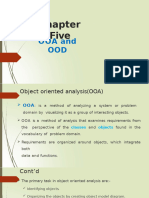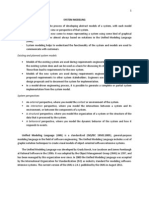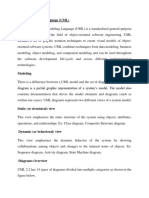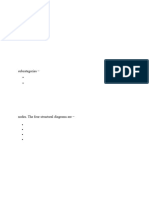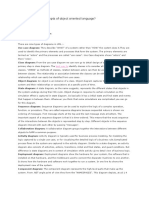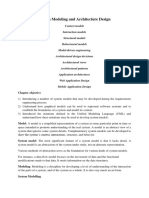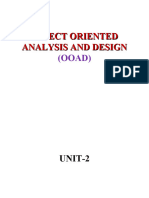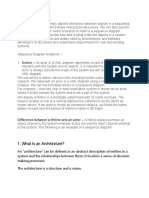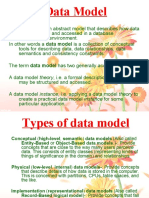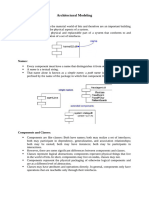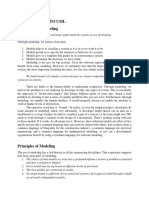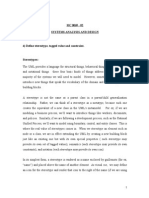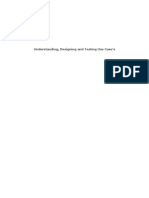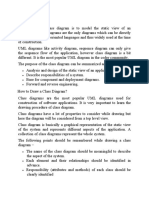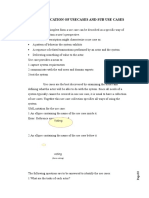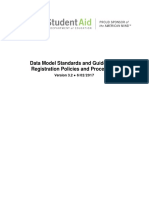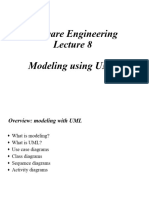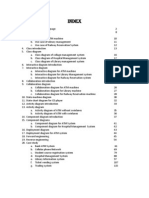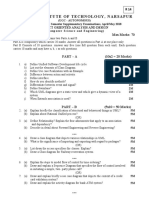0 ratings0% found this document useful (0 votes)
18 viewsLecture 1.2.4
Lecture 1.2.4
Uploaded by
Ashutosh mishraStructural modeling captures the static features of a system through diagrams like class diagrams, object diagrams, deployment diagrams, package diagrams, and component diagrams. These structural models represent the framework and organization of a system's components and their relationships, but do not describe dynamic behavior. Common structural models include class diagrams, which show classes and associations between them, and UML component diagrams, which can be used to present architectural models of a system.
Copyright:
© All Rights Reserved
Available Formats
Download as DOCX, PDF, TXT or read online from Scribd
Lecture 1.2.4
Lecture 1.2.4
Uploaded by
Ashutosh mishra0 ratings0% found this document useful (0 votes)
18 views4 pagesStructural modeling captures the static features of a system through diagrams like class diagrams, object diagrams, deployment diagrams, package diagrams, and component diagrams. These structural models represent the framework and organization of a system's components and their relationships, but do not describe dynamic behavior. Common structural models include class diagrams, which show classes and associations between them, and UML component diagrams, which can be used to present architectural models of a system.
Original Title
Lecture 1.2.4.docx
Copyright
© © All Rights Reserved
Available Formats
DOCX, PDF, TXT or read online from Scribd
Share this document
Did you find this document useful?
Is this content inappropriate?
Structural modeling captures the static features of a system through diagrams like class diagrams, object diagrams, deployment diagrams, package diagrams, and component diagrams. These structural models represent the framework and organization of a system's components and their relationships, but do not describe dynamic behavior. Common structural models include class diagrams, which show classes and associations between them, and UML component diagrams, which can be used to present architectural models of a system.
Copyright:
© All Rights Reserved
Available Formats
Download as DOCX, PDF, TXT or read online from Scribd
Download as docx, pdf, or txt
0 ratings0% found this document useful (0 votes)
18 views4 pagesLecture 1.2.4
Lecture 1.2.4
Uploaded by
Ashutosh mishraStructural modeling captures the static features of a system through diagrams like class diagrams, object diagrams, deployment diagrams, package diagrams, and component diagrams. These structural models represent the framework and organization of a system's components and their relationships, but do not describe dynamic behavior. Common structural models include class diagrams, which show classes and associations between them, and UML component diagrams, which can be used to present architectural models of a system.
Copyright:
© All Rights Reserved
Available Formats
Download as DOCX, PDF, TXT or read online from Scribd
Download as docx, pdf, or txt
You are on page 1of 4
Structural Modeling
Structural modeling captures the static features of a system. They consist
of the following −
Classes diagrams
Objects diagrams
Deployment diagrams
Package diagrams
Composite structure diagram
Component diagram
Structural model represents the framework for the system and this
framework is the place where all other components exist. Hence, the
class diagram, component diagram and deployment diagrams are part of
structural modeling. They all represent the elements and the mechanism
to assemble them.
The structural model never describes the dynamic behavior of the
system. Class diagram is the most widely used structural diagram.
Structural models of software display the organization of a system in
terms of the components that make up that system and their
relationships. Structural models may be static models, which show the
structure of the system design, or dynamic models, which show the
organization of the system when it is executing. You create structural
models of a system when you are discussing and designing the system
architecture.
UML class diagrams are used when developing an object-oriented
system model to show the classes in a system and the associations
between these classes. An object class can be thought of as a general
definition of one kind of system object. An association is a link between
classes that indicates that there is some relationship between these
classes. When you are developing models during the early stages of the
software engineering process, objects represent something in the real
world, such as a patient, a prescription, doctor, etc.
Structural models of software display the organization of a system in
terms of the components that make up that system and their
relationships. Structural models may be static models, which show the
structure of the system design or dynamic models, which show the
organization of the system when it is executing. These are not the same
things—the dynamic organization of a system as a set of interacting
threads may be very different from a static model of the system
components.
You create structural models of a system when you are discussing and
designing the system architecture. Architectural design is a particularly
important topic in software engineering and UML component, package,
and deployment diagrams may all be used when presenting architectural
models. Deeper details on architectural modeling will be covered in the
next chapter. Here we focus on the creation of the analysis-level class
diagrams only that are useful for better understanding of the problem
domain.
Domains represent the different subject matters that we need to
understand to build a system. A domain is an autonomous, real,
hypothetical or abstract world inhabited by a set of conceptual entities
that behave accordingto characteristic rules and policies. (Definition
from [MELLOR2002].) We abstract like things and and call
them classes. In forming such abstractions, we ignore most of the things
as our aim is to leave out details and concentrate only on the important
aspects. The remaining things are are grouped according to some
perceptions about what is means to be "like".
Data Dictionary
A data dictionary is a file or a set of files that includes a database's
metadata. The data dictionary hold records about other objects in the
database, such as data ownership, data relationships to other objects, and
other data. The data dictionary is an essential component of any
relational database. Ironically, because of its importance, it is invisible to
most database users. Typically, only database administrators interact
with the data dictionary.
The data dictionary, in general, includes information about the
following:
o Name of the data item
o Aliases
o Description/purpose
o Related data items
o Range of values
o Data structure definition/Forms
The name of the data item is self-explanatory.
Aliases include other names by which this data item is called DEO for
Data Entry Operator and DR for Deputy Registrar.
Description/purpose is a textual description of what the data item is used
for or why it exists.
Related data items capture relationships between data items e.g.,
total_marks must always equal to internal_marks plus external_marks.
Range of values records all possible values, e.g. total marks must be
positive and between 0 to 100.
Data structure Forms: Data flows capture the name of processes that
generate or receive the data items. If the data item is primitive, then data
structure form captures the physical structures of the data item. If the
data is itself a data aggregate, then data structure form capture the
composition of the data items in terms of other data items.
You might also like
- Online Voting System ContentsDocument19 pagesOnline Voting System Contentsm.k.snigdhaNo ratings yet
- CS 410/510 - Software Engineering System Modeling: The Big PictureDocument6 pagesCS 410/510 - Software Engineering System Modeling: The Big PictureNaveed HarshaNo ratings yet
- OOAD ProjectDocument23 pagesOOAD ProjectAnonymous EridERWJNo ratings yet
- Reduction OomdDocument18 pagesReduction OomdAlok KamalkarNo ratings yet
- Lecture 5 OOADDocument65 pagesLecture 5 OOADabasazn234No ratings yet
- SE-UNIT-3 Part 1Document6 pagesSE-UNIT-3 Part 1magantisivaprasad123No ratings yet
- Unit 5 System-ModelingDocument25 pagesUnit 5 System-ModelingMysto GanNo ratings yet
- AssignmentDocument31 pagesAssignmentHetal MerNo ratings yet
- System Modeling: Existing and Planned System ModelsDocument5 pagesSystem Modeling: Existing and Planned System ModelsMaricar SucalditoNo ratings yet
- Design Analysis: UML DiagramsDocument16 pagesDesign Analysis: UML DiagramsTejaNo ratings yet
- Abstraction DataDocument6 pagesAbstraction DataManojtiyanNo ratings yet
- System Modeling Unit3 NotesDocument32 pagesSystem Modeling Unit3 NotesAmruta IngoleNo ratings yet
- 6 - System ModelingDocument5 pages6 - System ModelingAreeba ArshadNo ratings yet
- DMDTDocument4 pagesDMDTnaveenath12No ratings yet
- SE Module3Document157 pagesSE Module3SreejithNo ratings yet
- Component DiagramsDocument6 pagesComponent DiagramsVENKTESH SINGHNo ratings yet
- Unit 7 Design-and-ImplementationDocument31 pagesUnit 7 Design-and-ImplementationMysto GanNo ratings yet
- Session 4Document68 pagesSession 4Isaac KariukiNo ratings yet
- Null 1Document6 pagesNull 1ajaydanish012No ratings yet
- Lecture 04 System Modelling Using UMLDocument41 pagesLecture 04 System Modelling Using UMLJooo loNo ratings yet
- Se 3Document32 pagesSe 3ahmedshamil4567No ratings yet
- 01object Oriented System Design and AnalysisDocument46 pages01object Oriented System Design and Analysisvishals2003128No ratings yet
- Uml DiagramsDocument22 pagesUml DiagramsPavan KalyanNo ratings yet
- What Are The Five Concepts of Object Oriented LanguageDocument3 pagesWhat Are The Five Concepts of Object Oriented LanguageSakthivel GovindarajNo ratings yet
- Object Oriented Design EducativeDocument429 pagesObject Oriented Design Educativerp singhNo ratings yet
- Uml ImportantDocument12 pagesUml ImportantAmandeep KumarNo ratings yet
- Explanetion For OOAD DiagramsDocument7 pagesExplanetion For OOAD Diagramsmsccs2nd2024No ratings yet
- Se Model 4Document8 pagesSe Model 4Praveen KumarNo ratings yet
- System Integration and Architecture 1Document8 pagesSystem Integration and Architecture 1charimaine hernandezNo ratings yet
- SFT Eng Unit 4 1.6Document44 pagesSFT Eng Unit 4 1.6shyam bkNo ratings yet
- SFT Eng Unit 4 1.4Document35 pagesSFT Eng Unit 4 1.4shyam bkNo ratings yet
- UNIT 1 - UML IntroDocument28 pagesUNIT 1 - UML IntroDEVIBALA SUBRAMANIANNo ratings yet
- Diagrams IntroductionDocument9 pagesDiagrams IntroductionHan JeeNo ratings yet
- Ooad Unit 22Document43 pagesOoad Unit 22SumanthvarmaNo ratings yet
- UML Notes Unit 1Document10 pagesUML Notes Unit 1onlineganesh87No ratings yet
- Se Lab FileDocument9 pagesSe Lab FileParth SarthiNo ratings yet
- Software Engineering Data Model: - Relationship Model (ER Model) Is ADocument10 pagesSoftware Engineering Data Model: - Relationship Model (ER Model) Is AVISHNU4JESUS1No ratings yet
- Entity-Relationship ModelDocument11 pagesEntity-Relationship ModelOleksandr CheNo ratings yet
- CS619 Helping MaterialDocument4 pagesCS619 Helping MaterialIznah KhanNo ratings yet
- Software Engineering-Unit 4Document43 pagesSoftware Engineering-Unit 4anujacsNo ratings yet
- Uml HandoutDocument63 pagesUml Handoutbiruk mollaNo ratings yet
- ModelDocument17 pagesModelkhushali16No ratings yet
- PT1 UmlDocument50 pagesPT1 UmlPUGALENTHI M SNo ratings yet
- Unit-2 Notes OosdDocument35 pagesUnit-2 Notes Oosdad.lusifar007No ratings yet
- Diagrams IntroductionDocument8 pagesDiagrams IntroductionHan JeeNo ratings yet
- UML Diagram Types GuideDocument17 pagesUML Diagram Types GuideahmedNo ratings yet
- OOAD unit-5Document9 pagesOOAD unit-5katyayini33979No ratings yet
- Uml 2Document29 pagesUml 2Gaurav VermaNo ratings yet
- Management Information System Ch-6 Data Flow Diagrams: 0-Level DFDDocument6 pagesManagement Information System Ch-6 Data Flow Diagrams: 0-Level DFDHamid BashirNo ratings yet
- Conceptual Model of The Unified Modeling LanguageDocument22 pagesConceptual Model of The Unified Modeling Languagesalamrockybhai70077263No ratings yet
- Chapter 2Document48 pagesChapter 2surafel123emiruNo ratings yet
- Lecture Notes 1.3.4Document4 pagesLecture Notes 1.3.4Ashutosh mishraNo ratings yet
- OOSEDocument33 pagesOOSEAMAN BHARDWAJNo ratings yet
- Se Unit 4 & 5Document67 pagesSe Unit 4 & 5kirankohli040600No ratings yet
- MC 0069-02 Sys Analy and DesignDocument11 pagesMC 0069-02 Sys Analy and DesignshrikrushNo ratings yet
- Use Case DiagramDocument12 pagesUse Case DiagramThilak_Saravan_1094No ratings yet
- UML U M L: Nified Odeling AnguageDocument37 pagesUML U M L: Nified Odeling AnguageAshish UpretiNo ratings yet
- Data Models: Entity Relationship Data ModelDocument3 pagesData Models: Entity Relationship Data ModelAsfand Yar AliNo ratings yet
- UML Diagram PresentationDocument30 pagesUML Diagram PresentationRubin Chaulagain100% (2)
- Lecture Notes 1.3.6Document13 pagesLecture Notes 1.3.6Ashutosh mishraNo ratings yet
- Lecture 1.2.1Document5 pagesLecture 1.2.1Ashutosh mishraNo ratings yet
- Soft Engineering Assignment 1Document1 pageSoft Engineering Assignment 1Ashutosh mishraNo ratings yet
- Lecture Notes 1.3.3Document2 pagesLecture Notes 1.3.3Ashutosh mishraNo ratings yet
- Lecture 1.3.1Document4 pagesLecture 1.3.1Ashutosh mishraNo ratings yet
- Lecture 1.2.3Document8 pagesLecture 1.2.3Ashutosh mishraNo ratings yet
- Software Engineering Lecture 1.1.4Document10 pagesSoftware Engineering Lecture 1.1.4Ashutosh mishraNo ratings yet
- Lecture Notes 1.3.2Document3 pagesLecture Notes 1.3.2Ashutosh mishraNo ratings yet
- Lecture Notes 1.3.5Document5 pagesLecture Notes 1.3.5Ashutosh mishraNo ratings yet
- Lecture Notes 1.3.4Document4 pagesLecture Notes 1.3.4Ashutosh mishraNo ratings yet
- Software Engineering Lec 1Document3 pagesSoftware Engineering Lec 1Ashutosh mishraNo ratings yet
- Software Engineering Lecture 1.1.5Document8 pagesSoftware Engineering Lecture 1.1.5Ashutosh mishraNo ratings yet
- Software Engineering Lecture 1.1.3Document3 pagesSoftware Engineering Lecture 1.1.3Ashutosh mishraNo ratings yet
- Software Engineering Lecture 1.1.2Document4 pagesSoftware Engineering Lecture 1.1.2Ashutosh mishraNo ratings yet
- Lecture 1.2.2Document4 pagesLecture 1.2.2Ashutosh mishraNo ratings yet
- Airline Reservation SystemDocument81 pagesAirline Reservation SystemBanagiri AkhilNo ratings yet
- SD 10 UmlDocument33 pagesSD 10 UmlZaenal abidinNo ratings yet
- Online SystemDocument35 pagesOnline SystemPravashSahoo100% (1)
- Class DiagramsDocument21 pagesClass DiagramsYaasir Yare 2020No ratings yet
- Demo Black BookDocument47 pagesDemo Black BookviniNo ratings yet
- Coffe Machine ModelDocument60 pagesCoffe Machine ModelMirna D. OjedaNo ratings yet
- UML Basics: Lecturer: Valentina Presutti Academic Year: 2009/2010 Courtesy of Paolo CiancariniDocument139 pagesUML Basics: Lecturer: Valentina Presutti Academic Year: 2009/2010 Courtesy of Paolo CiancarinilakshmiNo ratings yet
- Data Model Standards and GuidelinesDocument72 pagesData Model Standards and GuidelinesAlvin Giovanni Mingguw100% (2)
- ClassDiagramDocument33 pagesClassDiagramkaosar alamNo ratings yet
- Uml Modeling Using Magicdraw: Uml For Java ProgrammersDocument23 pagesUml Modeling Using Magicdraw: Uml For Java ProgrammersFranz LeónNo ratings yet
- SDA UML ModelingDocument13 pagesSDA UML ModelingMudasser HussainNo ratings yet
- Cs2357 Ooad Lab ManualDocument240 pagesCs2357 Ooad Lab ManualheyramzzNo ratings yet
- Software Engineering: Topics: 1) Uml and Use-Case Diagram 2) Reverse Engineering 3) Rational RoseDocument12 pagesSoftware Engineering: Topics: 1) Uml and Use-Case Diagram 2) Reverse Engineering 3) Rational RoseM khawarNo ratings yet
- Practical UML - A Hands-On Introduction For DevelopersDocument10 pagesPractical UML - A Hands-On Introduction For DevelopersRajneeshNo ratings yet
- Healthy Warehouse ProgressDocument40 pagesHealthy Warehouse ProgressSuhailNo ratings yet
- Cac Phan Mem Quan Ly Tuoi PDFDocument336 pagesCac Phan Mem Quan Ly Tuoi PDFNguyen Van KienNo ratings yet
- Bachelor Thesis Haw HamburgDocument7 pagesBachelor Thesis Haw HamburgPayForSomeoneToWriteYourPaperUK100% (2)
- Lecture 8 Modelling Using UMLDocument39 pagesLecture 8 Modelling Using UMLmennasolimanali2No ratings yet
- SWE 621: Software Modeling and Architectural Design Static ModelingDocument20 pagesSWE 621: Software Modeling and Architectural Design Static ModelingLaura CraigNo ratings yet
- Design of A Whole Sale Inventory Management System Using UmlDocument7 pagesDesign of A Whole Sale Inventory Management System Using UmlNafi Siam100% (1)
- Working With The Class Diagrams of UMLDocument5 pagesWorking With The Class Diagrams of UMLghazi membersNo ratings yet
- SE Chapter 3-5Document137 pagesSE Chapter 3-5Shafi EsaNo ratings yet
- CS2357 Set1 PDFDocument6 pagesCS2357 Set1 PDFanish.t.pNo ratings yet
- Week 2 - OOADDocument71 pagesWeek 2 - OOADNicholasChongNo ratings yet
- Bus Pass Management System Documentation 2Document82 pagesBus Pass Management System Documentation 2Nilesh KumarNo ratings yet
- Executive Summary/Abstract: Tech DriveDocument71 pagesExecutive Summary/Abstract: Tech DrivepraveenaNo ratings yet
- Final Year ProjectDocument60 pagesFinal Year ProjectMeMyselfNo ratings yet
- TicketVendingMachine SuryaNSDocument35 pagesTicketVendingMachine SuryaNSSurya Ns100% (2)
- Bvraju Institute of Technology, Narsapur: Code No: R14Document2 pagesBvraju Institute of Technology, Narsapur: Code No: R14Vamshi KrishnaNo ratings yet





